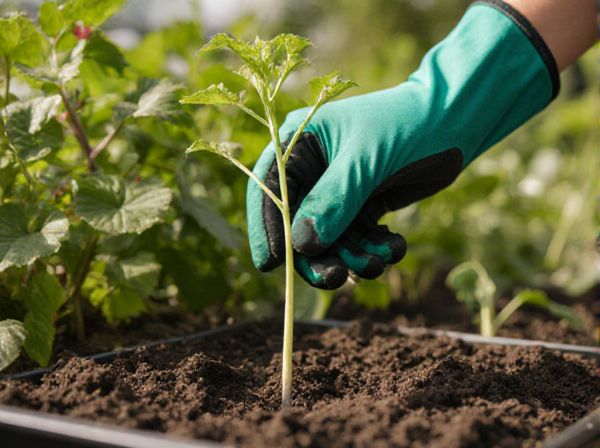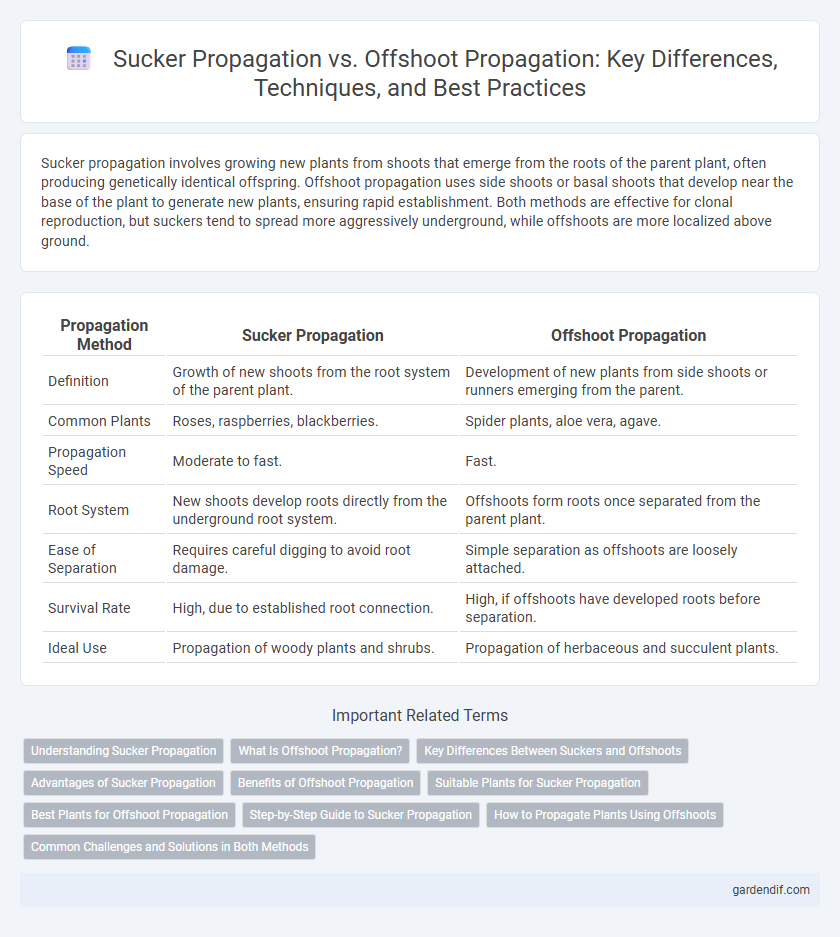
Sucker Propagation vs Offshoot Propagation Illustration
Sucker propagation involves growing new plants from shoots that emerge from the roots of the parent plant, often producing genetically identical offspring. Offshoot propagation uses side shoots or basal shoots that develop near the base of the plant to generate new plants, ensuring rapid establishment. Both methods are effective for clonal reproduction, but suckers tend to spread more aggressively underground, while offshoots are more localized above ground.
Table of Comparison
| Propagation Method | Sucker Propagation | Offshoot Propagation |
|---|---|---|
| Definition | Growth of new shoots from the root system of the parent plant. | Development of new plants from side shoots or runners emerging from the parent. |
| Common Plants | Roses, raspberries, blackberries. | Spider plants, aloe vera, agave. |
| Propagation Speed | Moderate to fast. | Fast. |
| Root System | New shoots develop roots directly from the underground root system. | Offshoots form roots once separated from the parent plant. |
| Ease of Separation | Requires careful digging to avoid root damage. | Simple separation as offshoots are loosely attached. |
| Survival Rate | High, due to established root connection. | High, if offshoots have developed roots before separation. |
| Ideal Use | Propagation of woody plants and shrubs. | Propagation of herbaceous and succulent plants. |
Understanding Sucker Propagation
Sucker propagation involves encouraging new shoots or "suckers" that grow from the roots or lower stem of a parent plant, facilitating a natural method of cloning. This technique is efficient for species like raspberries and blackberries, allowing gardeners to propagate genetically identical plants with minimal intervention. Understanding sucker propagation helps optimize plant density and rejuvenation in orchard or garden settings by leveraging the plant's natural growth habits.
What Is Offshoot Propagation?
Offshoot propagation involves the natural growth of new plants from the base or root system of the parent plant, producing genetically identical clones. These offshoots, also known as pups or offsets, develop their own root systems before detachment, ensuring higher survival rates when transplanted. This method is commonly used in plants like aloe vera, agave, and certain succulents for efficient and reliable propagation.
Key Differences Between Suckers and Offshoots
Sucker propagation involves shoots emerging from the root system or base of a plant, often used to regenerate species like raspberries and blackberries, whereas offshoot propagation involves lateral stems growing from the mother plant's crown or rhizome, common in species like agave and yucca. Suckers tend to be more vigorous and can develop into a separate plant with an independent root system, while offshoots usually remain connected to the parent plant until they develop sufficient roots. Understanding these key differences helps optimize propagation techniques for different plant species based on growth habits and root development.
Advantages of Sucker Propagation
Sucker propagation offers advantages such as faster establishment and stronger root development compared to offshoot propagation. This method allows the new plants to inherit the vigor and disease resistance of the parent by directly using natural shoots emerging from the base. Furthermore, suckers tend to adapt more quickly to soil conditions, promoting higher survival rates in diverse environments.
Benefits of Offshoot Propagation
Offshoot propagation promotes stronger plant development by producing clones with an established root system, leading to higher survival rates and faster growth compared to sucker propagation. This method reduces the risk of disease transmission often associated with suckers, ensuring healthier offspring. Enhanced nutrient uptake and stability in offshoots result in more robust plants thriving in diverse environmental conditions.
Suitable Plants for Sucker Propagation
Sucker propagation is particularly suitable for plants like raspberry, blackberry, and horseradish, which naturally produce vigorous underground suckers ideal for division and replanting. Unlike offshoot propagation, which relies on above-ground shoots or runners, sucker propagation exploits the plant's ability to form new growth from its root system, ensuring genetically identical offspring. This method is effective for hardy perennials and shrubs that spread via root suckers, enabling easier establishment and longevity in new locations.
Best Plants for Offshoot Propagation
Offshoot propagation is highly effective for plants such as banana, spider plant (Chlorophytum comosum), and agave, which produce natural lateral shoots or "offshoots" that can be easily separated and replanted. These offshoots retain the genetic identity of the parent plant, ensuring consistent growth and characteristics. Compared to sucker propagation, offshoot propagation generally offers higher success rates with reduced risk of damage to the main plant.
Step-by-Step Guide to Sucker Propagation
Sucker propagation involves carefully extracting shoots that emerge from the base of a parent plant to encourage robust root development. Begin by selecting healthy suckers and gently digging around the base to avoid root damage; separate them using a sharp, sterilized tool and plant immediately in nutrient-rich soil. Ensure consistent moisture and partial shade while the suckers establish to maximize survival and growth success rates compared to offshoot propagation.
How to Propagate Plants Using Offshoots
Offshoot propagation involves separating the small plantlets, or offshoots, that grow from the base of a parent plant and replanting them to develop new, independent plants. To propagate using offshoots, carefully dig around the base of the offshoot to expose its roots, gently separate it from the parent plant without damaging the root system, and plant it in well-drained soil with adequate moisture and indirect sunlight. This method encourages faster establishment and growth compared to sucker propagation, as offshoots generally have a more developed root system at the time of separation.
Common Challenges and Solutions in Both Methods
Sucker propagation and offshoot propagation commonly face challenges such as inconsistent rooting, pest infestations, and nutrient deficiencies, which can hinder healthy plant development. Ensuring optimal soil moisture, using rooting hormones, and maintaining pest control are effective solutions to improve success rates in both methods. Proper environmental control, including temperature and light regulation, enhances root formation and overall propagation efficiency.
Sucker Propagation vs Offshoot Propagation Infographic

 gardendif.com
gardendif.com